Hi-X60
back to Austrian Audio
back to measurements
home
Published: Feb-10-2023, updated Mar-17-2023
NO SMOOTHING is applied to the shown plots. Most measurement sites have some smoothing applied which ‘irons flat’ sharp peaks and ‘wiggles’. I do not use smoothing because some info about sound quality is lost when plots are smoothed.
Aside from a small correction of the microphone itself also some correction in the lowest frequencies is applied to the plots to compensate for the perceived loss of bass when using headphones. This is described HERE in more detail.
A ‘horizontal‘ frequency response curve on the shown frequency response plots on this website thus indicates a perceived ‘flat’ tonal signature.
ALL measurements are made with a good SEAL on a flatbed measurement rig.
The shape of your head, bone structure, pad size, pad ‘softness, (compliance), hair or no hair and or wearing glasses may (drastically) change the frequency response of some headphones, so… your personal experience may differ substantially from these plots.
Frequency response (tonal balance) is the most sound-determining aspect of headphones. A horizontal line shows audible neutral response in the plots on this website. Deviations in different severity at different frequency bands have an effect on the sound character.
The bigger the deviation the stronger the effect.
Below an aid to help determining the sound character of headphones with relation to the frequency response.

Austrian Audio Hi-X60

The Austrian Audio Hi-X60 is a closed over-ear headphone intended for studio usage. It costs between € 350.- and € 400.- which, given the build quality, is not cheap nor expensive.
The build quality appears quite high and the headphone feels very sturdy and is very suited for studio usage. The pads and headband padding is available as spare parts.
The headphone comes with 2 cables, a 3m long fixed cable and a 1.2m long cable.
Those cables connect to the headphone using a proprietary twist-lock 2.5mm gold plated TRS jack.
This means the headphone can not be used with balanced outputs. Fortunately this is not needed at all. Most professional equipment uses TRS jacks anyway.
The cables are microphonic alas, this means when you touch the cable (or rubs against clothes) this is audible in the left cup.
The cables terminate in a gold-plated 3.5mm TRS jack with screw-on 6.3mm adapter.
The headband can extend 30mm. The headband is pleather covered and feels soft enough and is wide enough not to create hot-spots on the head. Quality materials are used, metal and high quality plastics. Everything feels sturdy and operates smoothly and well defined. High construction quality.
The clamping force is on the high side with its 5N.
The cups can be rotated 90 degrees (so fold flat) but have a limited tilt but enough to to create a good fit on most heads.The cups can fold into the headband and also fold flat so the headphones can be transported easily without taking up too much space.
The ‘replaceable’ (glued with double sided tape) pads have soft memory foam inside and are covered with pleather (PVC covered cloth with leather look). Room for the ears is plenty and much bigger than most other headphones.
The pads are quite comfortable. The internal height is a very generous 75mm and the width is 50mm. The 28mm depth also is unusually big so plenty of room, even for the biggest ears.
There is a big L and R visible in the cups so there is no doubt on how they should be placed on the head.
The sensitivity is very high (117dB/V @ 1kHz) and with a 25Ω impedance it can play quite loud even from portable sources like phones etc. Even with EU phones with output power restrictions it can play loud enough. Also the impedance does not vary over the audible range so it the output resistance of the headphone source does not matter. It does not change tonal balance on different output resistance amplifiers.
This headphone is not very low in weight (321 gr without the cable) but also not amongst the heaviest ones. Most of the weight comes from the usage of sturdy metal parts being used in most of the headphone.
There is a good attenuation of outside noises.
This headphone was kindly loaned to me by a reader so cannot make more measurements or experiment with it.
specifications:
Type: Over-ear, closed
Usage: Studio, home, Portable
Isolation: high (passive)
Driver type: dynamic
Pads: replaceable, pleather
Inner pad dimensions: Height: 75mm, width: 50 mm, depth: 28mm
Collapsible: yes, and can fold flat.
Headphone connector: 2.5mm locking TRS jack
Cable: 1.2m and 3m straight with gold plated 3.5mm TRS plug + 6.3 mm screw-on adapter
Driver size: ø 44mm
Max. power rating: 0.15W
Max. voltage: 1.6V
Max. current: 65mA
Max. S.P.L.: 121dB
Impedance: 25Ω (measured)
Sensitivity: 117dB @ 1V @ 1kHz
Efficiency: 101dB @ 1mW @ 1kHz
Weight: 321g. (without cable)
Color: black
Clamping force: high (5N)
Accessories: 6.3mm adapter, 2 cables of different length, carrying pouch.
Sound description:
The sound is very dynamic and clear. Bass is not accentuated but extends very deep. That is…. provided a perfect seal is achieved. Bass quality is very good.
Mids have a sharp ‘edge’ and sound forward and realistic/neutral. Not warm/full in the mids.
Treble is of good quality and quantity.
measurements:
Below the frequency response of the Hi-X60 (left, right) from 20Hz to 20kHz.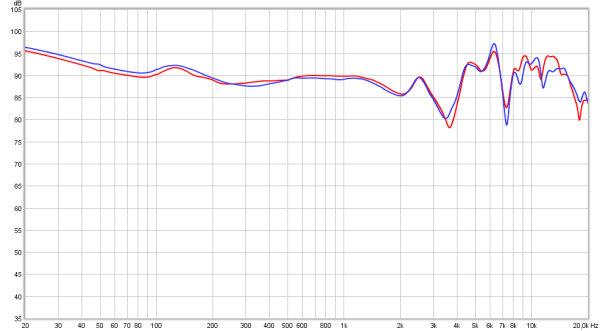
To show the bass extension below the response but all the way down to 3Hz.
Channel matching is excellent. From 10Hz to 50Hz the frequency response is sloping downwards. It should be noted this is with a perfect seal ! This is the sub-bass and low-bass region.
From 60Hz to 1.5kHz the response is ‘neutral’. Because there is a small drop from 200hz to 500Hz the ‘slope’ of the mids is rising about 2dB up to 1kHz so the sound signature, despite having elevated low bass, has no ‘warmth’ nor the feel of elevated bass. Deep rumbles are present.
The upper mids/lower treble, however, is a bit too elevated which can make certain instruments and voices a bit too bright/sharp (accentuated). Fortunately EQ or a filter will help substantially here.
Treble is extended enough, not splashy nor grainy. It does not have a ‘ethereal’ and ‘airy’ character that can often be found in higher end Hi-Fi headphones.
Still… 20kHz is more than good enough for even the youngest of ears.
Very good for studio usage but less suited for music enjoyment unless the elevated upper mids/lower treble has been addressed. With that part toned down the Hi-X60 sounds excellent and enjoyable.
Like near-field monitors, not as speakers in a room or with any room correction targets. It lacks ‘warmth’ for that.
Below the phase response of the Hi-X60 (left, right)
 Slow phase shifts are not very audible. Steep changes in a narrow frequency bands may well be audible. between 3.5kHz and 8khz there are some variances in narrow frequency bands.
Slow phase shifts are not very audible. Steep changes in a narrow frequency bands may well be audible. between 3.5kHz and 8khz there are some variances in narrow frequency bands.
Seal
Seal is quite important for closed headphones and this headphone is no exception. Below the effect on the tonal balance is shown when the seal is not perfect. The bass suffers. Perfect seal, seal broken with thick armed glass resting against the skin, seal broken with thin armed glasses not resting against the skin

Breaking the seal lowers the amount of bass substantially. A small leakage is already quite audible and not necessarily a bad thing but lower bass is gone. With a considerable seal breakage (thick armed glasses not resting against the skin) the bass is gone and the sound becomes ‘cuppy’.
Comparison
Below the Hi-X60 versus some other closed (and 2 open) headphones in various price ranges.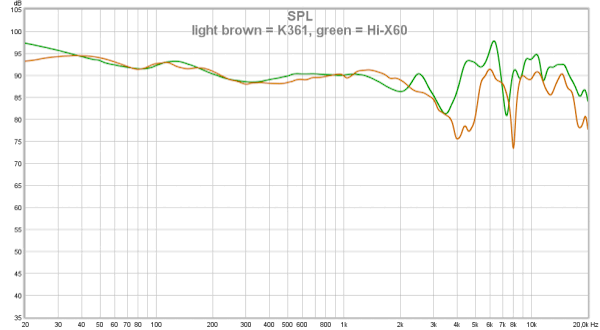
output resistance / damping-factor
As this is a closed dynamic headphone the frequency response can be amplifier output resistance dependent when certain higher output resistance amplifiers are used.
Instead of showing impedance plots, which are hard to ‘read’ when it comes to assessing the tonal balance change in the real world, the Hi-X60 is measured via a few different resistance outputs (0.2Ω, 10Ω, 32Ω and 120Ω). On a higher output resistance amplifier the output level will be lower of course due to voltage division. To compensate for this the amplifier is turned up to the same level (14.7dB for 120Ω at 1kHz in this case at max. volume setting). This way the plots are overlaid and it is easier to see how the tonal balance changes.  The headphone does not react at ll to higher output resistances. This means it can be used from various interfaces and music instruments as these often have output impedance that can range between 10Ω and 100Ω.
The headphone does not react at ll to higher output resistances. This means it can be used from various interfaces and music instruments as these often have output impedance that can range between 10Ω and 100Ω.
Below the distortion measurements of the Hi-X60 (Right channel).
 The measurements are made at 90 dB SPL. The plot above shows the level differences between the signal (upper trace) and the harmonics. Most people prefer to see percentages instead of level differences so below the exact same plot except ‘normalized’ to the actual signal and level differences given in percentages.
The measurements are made at 90 dB SPL. The plot above shows the level differences between the signal (upper trace) and the harmonics. Most people prefer to see percentages instead of level differences so below the exact same plot except ‘normalized’ to the actual signal and level differences given in percentages.
 Distortion levels are very low and is exemplary and rivals that of planar headphones and closed headphones. It remains distortion free even at quite loud levels.
Distortion levels are very low and is exemplary and rivals that of planar headphones and closed headphones. It remains distortion free even at quite loud levels.
The actual 2nd harmonic distortion may well be much lower than shown. A shortcoming of my measurement rig. Also ignore the 50Hz peak (mains hum).
Linearity
To see how severe the compression is the Hi-X60 is measured 4 times. Once at 70dB, 80dB, 90dB and 100dB SPL (at 1kHz). When the traces are overlaid and have the same shape then there is no compression visible. 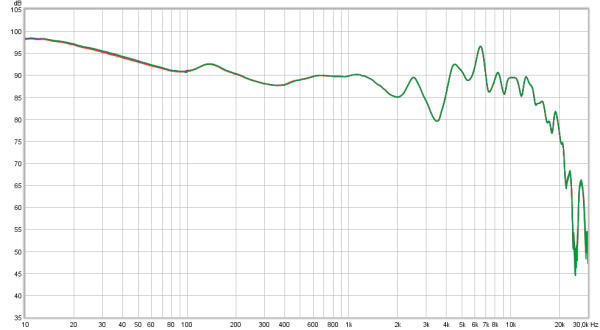 There is no compression at least not up to 100dB SPL (and 108dB SPL @ 10Hz) which shows great linearity and thus low distortion,
There is no compression at least not up to 100dB SPL (and 108dB SPL @ 10Hz) which shows great linearity and thus low distortion,
Below the CSD of the Hi-X60 (Left and Right are overlaid).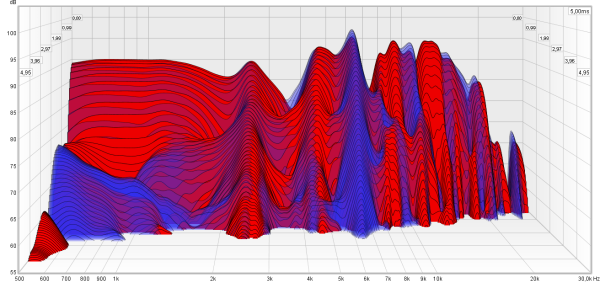 At 3.5kHz and 6kHz there are some resonances showing. All very short lived so not problematic nor audible.
At 3.5kHz and 6kHz there are some resonances showing. All very short lived so not problematic nor audible.
Below the spectrum plot of the Hi-X60 (Left channel). 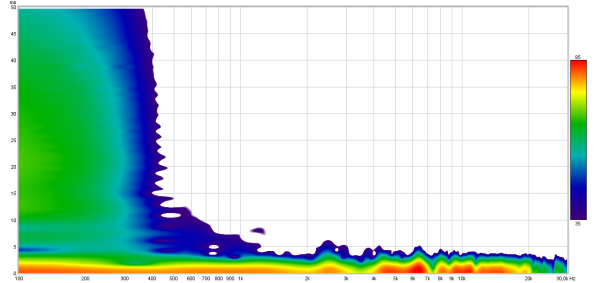 Below 300Hz the frequencies tend to drop a bit less fast than desirable.
Below 300Hz the frequencies tend to drop a bit less fast than desirable.
Below the group delay plot of the Hi-X60 (left, right)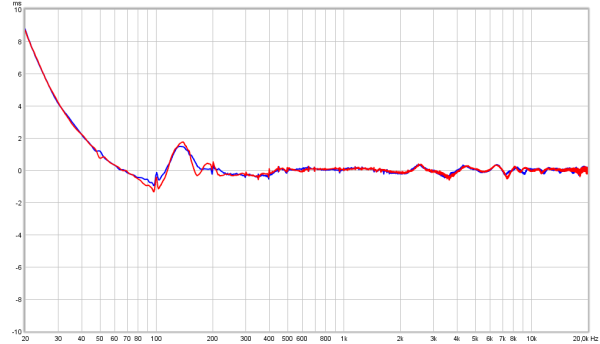 Around 120Hz there is some ‘pad bounce’ but this is very small. No major issues here.
Around 120Hz there is some ‘pad bounce’ but this is very small. No major issues here.
Also some resonances are visible at 2.5kHz, 3.5kHz and around 7kHz.
The step response of the Hi-X60 (left, right) The initial rise reaches the same levels as the signal in the first ms. There is a small peak around 200μs. The initial rising edge and that small peak are responsible for the ‘sharp’ contour in the sound.
The initial rise reaches the same levels as the signal in the first ms. There is a small peak around 200μs. The initial rising edge and that small peak are responsible for the ‘sharp’ contour in the sound.
After 1ms there is a rise and from 2ms (50Hz) the response does not drop showing the exceptional bass extension. Note: this is only with a perfect seal.
treble reduction
There is a bit too much energy between 4kHz and 8kHz when this headphone is used for music enjoyment.
This can easily be corrected using parametric EQ or even graphic EQ but this is not always possible or easy to do. In those cases the filter schematic below will lower the upper-mids/lower treble to much more enjoyable levels. Also in studios when having to plug it in various devices and not all of them having an option to EQ and one does not want/need the emphasis in this region the filter below can be a very good solution. This filter can also be bought fully build on customer specs (plugs, length)

The effect of the filter is shown below. (left channel)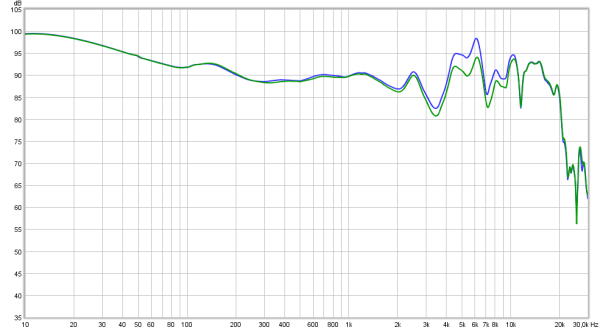
The filter only lowers the part that needs to be lowered.
summary
The Austrian Audio Hi-X60 is a closed over-ear headphone for studio usage. It has a very high build quality and feel. Comfort wise this headphone will fit most heads just fine. There is more than enough room even for big ears. This is surprising to see as most headphones have much smaller pads and room for the ears. This also means that proper positioning is needed as it is easy to have it not centered around the ears which mildly affects the perceived tonal balance.
The clamping force is rather high (5N) which gave me a mild headache after an hour or so.
I reckon bending the steel headband could alleviate this but as this was not my headphone I did not attempt this. For studio usage and to ensure it stays in place, combined with the small surface area the pads contact the head, the high-ish pressure is desirable. Less so when enjoying music for longer periods.
In the end a headphone is all about the sound and usage. For studio usage it is fine as is. It has a ‘laser-like’ sound where one can easily pick out ‘nasty’ things in the recording as these aspects are emphasized a bit. This is less desirable for music enjoyment unless one has really good (classical) recordings.
Fortunately this headphone reacts well to some EQ or the passive filter (when EQ is not possible). In this case the headphone sounds very clean and realistic/neutral without added ‘warmth’.
This headphone is quite sensitive so can play loud, even from a phone and it being a closed headphone makes it quite, besides being useful in the studio as a tool even directly from audio interfaces, also suited for portable duties on a phone, tablet or laptop.
The cable is microphonic and could have pointed a bit more forward so the cable would make less contact with one’s clothes.
Prices are usually somewhere between € 350.- and € 400.- which, given the build quality and sound is a realistic price.
In short:
A very good and sturdy studio tool that with some EQ/filtering can also be used for music enjoyment.
Niggles: weight, microphonic cable, clamping force and for music enjoyment a bit on the ‘cold’ and bright/sharp/analytical side. The latter can easily be corrected.

¡Gracias!